7 Specifications
7.1 Absolute Maximum Ratings (1)
|
MIN |
MAX |
UNIT |
| Input Voltages |
VIN to GND |
-0.3 |
65 |
V |
| SHDN to GND |
-0.3 |
65 |
| FB to GND |
-0.3 |
7 |
| CB to SW |
-0.3 |
7 |
| Output Voltages |
SW to GND |
-0.3 |
65 |
| SW to GND less than 30 ns transients |
-2 |
65 |
| TJ Operation Junction temperature |
-40 |
150 |
°C |
(1) Stresses beyond those listed under Absolute Maximum Ratings may cause permanent damage to the device. These are stress ratings only, which do not imply functional operation of the device at these or any other conditions beyond those indicated under Recommended Operating Conditions. Exposure to absolute-maximum-rated conditions for extended periods may affect device reliability.
7.2 Handling Ratings
|
MIN |
MAX |
UNIT |
| Tstg |
Storage temperature range |
-55 |
165 |
°C |
| V(ESD) |
Electrostatic discharge |
Human body model (HBM), per ANSI/ESDA/JEDEC JS-001, all pins(1) |
|
2000 |
V |
| Charged device model (CDM), per JEDEC specification JESD22-C101, all pins(2) |
|
500 |
(1) JEDEC document JEP155 states that 500-V HBM allows safe manufacturing with a standard ESD control process.
(2) JEDEC document JEP157 states that 250-V CDM allows safe manufacturing with a standard ESD control process.
7.3 Recommended Operating Conditions
over operating free-air temperature range (unless otherwise noted) (1)
|
MIN |
MAX |
UNIT |
| Buck Regulator |
VIN |
4 |
60 |
V |
| CB |
4 |
66 |
| CB to SW |
-0.3 |
6 |
| SW |
-0.3 |
60 |
| FB |
0 |
5.5 |
| Control |
SHDN |
0 |
60 |
| Temperature |
Operating junction temperature range, TJ |
-40 |
125 |
°C |
7.4 Thermal Information
over operating free-air temperature range (unless otherwise noted)
|
THERMAL METRIC (1) |
SOT
(6 PINS) |
UNIT |
| RθJA |
Junction-to-ambient thermal resistance |
102 |
°C/W |
| RθJCtop |
Junction-to-case (top) thermal resistance |
36.9 |
| RθJB |
Junction-to board characterization parameter |
28.4 |
(1) All numbers apply for packages soldered directly onto a 3" x 3" PC board with 2 oz. copper on 4 layers in still air in accordance to JEDEC standards. Thermal resistance varies greatly with layout, copper thickness, number of layers in PCB, power distribution, numberof thermal vias, board size, ambient temperature, and air flow.
7.5 Electrical Characteristics
Limits apply over the recommended operating junction temperature (TJ) range of -40°C to +125°C, unless otherwise stated. Minimum and Maximum limits are specified through test, design or statistical correlation. Typical values represent the most likely parametric norm at TJ = 25°C, and are provided for reference purposes only. Unless otherwise specified, the following conditions apply: VIN = SHDN = 12V
| PARAMETER |
TEST CONDITIONS |
MIN |
TYP |
MAX |
UNIT |
| VIN (Input Power Supply) |
| VIN |
Operating input voltage |
|
4 |
|
60 |
V |
| ISHDN |
Shutdown supply current |
VEN = 0 V |
|
1 |
3 |
µA |
| IQ |
Operating quiescent current (non-switching) |
no load, VIN = 12 V |
|
28 |
|
µA |
| UVLO |
Undervoltage lockout thresholds |
Rising threshold |
|
|
4 |
V |
| Falling threshold |
3 |
|
|
| SHDN |
| VSHDN_Thre |
Rising SHDN Threshold Voltage |
|
1.05 |
1.25 |
1.38 |
V |
| ISHDN |
Input current |
SHDN = 2.3 V |
|
-4.2 |
|
µA |
| SHDN = 0.9 V |
|
-1 |
|
| ISHDN_HYS |
Hysteresis current |
|
|
-3 |
|
µA |
| HIGH-SIDE MOSFET |
|
| RDS_ON |
On-resistance |
VIN = 12 V, CB to SW = 5.8 V |
|
900 |
|
mΩ |
| VOLTAGE REFERENCE (FB PIN) |
|
| VFB |
Feedback voltage |
|
0.747 |
0.765 |
0.782 |
V |
| CURRENT LIMIT |
| ILIMIT |
Peak Current limit |
VIN = 12 V, TJ = 25°C |
|
1200 |
|
mA |
|
|
|
1700 |
| THERMAL PERFORMANCE |
| TSHDN (1) |
Thermal shutdown threshold |
|
|
170 |
|
ºC |
| THYS (1) |
Hysteresis |
|
|
10 |
|
ºC |
(1) Ensured by design
7.6 Switching Characteristics
over operating free-air temperature range (unless otherwise noted)
| PARAMETER |
TEST CONDITIONS |
MIN |
TYP |
MAX |
UNIT |
| SW (SW PIN) |
| fSW |
Switching frequency |
LMR16006X |
595 |
700 |
805 |
kHz |
| LMR16006Y |
1785 |
2100 |
2415 |
| TON_MIN (1) |
Minimum turn-on time |
fSW = 2.1 MHz |
|
80 |
|
ns |
| DMAX |
Maximum duty cycle |
LMR16006X |
|
96% |
|
|
| LMR16006Y |
|
97% |
|
(1) Ensured by design.
7.7 Typical Characteristics
Unless otherwise specified the following conditions apply: VIN = 12 V, fSW = 700 kHz, L1 = 22 µH, Cout = 10 µF, TA = 25°C.
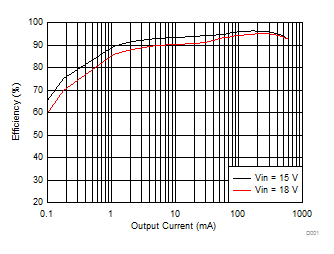
| VOUT = 12 V |
fSW = 700 kHz |
|
|
|
|
Figure 1. Efficiency vs. Load Current
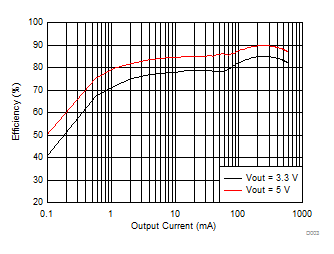 Figure 3. Efficiency vs. Load Current
Figure 3. Efficiency vs. Load Current
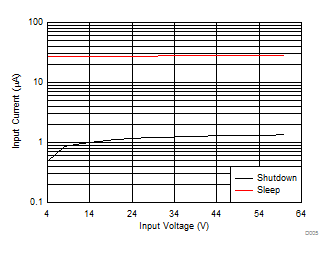 Figure 5. Shut-Down Current and Quiescent Current
Figure 5. Shut-Down Current and Quiescent Current
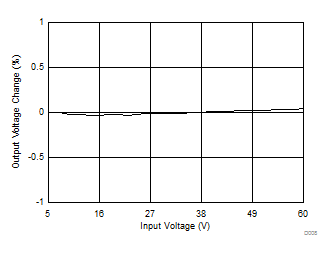 Figure 7. Line Regulation
Figure 7. Line Regulation
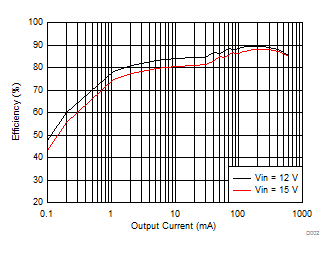 Figure 2. Efficiency vs. Load Current
Figure 2. Efficiency vs. Load Current
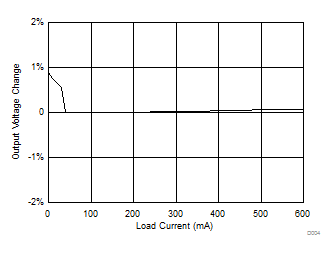 Figure 4. Load Regulation
Figure 4. Load Regulation
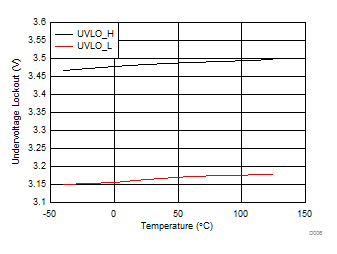 Figure 6. UVLO Threshold
Figure 6. UVLO Threshold
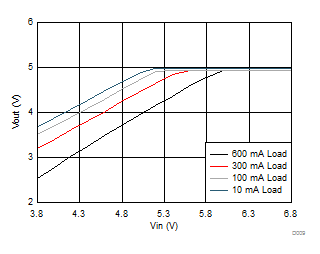 Figure 8. Dropout Curve
Figure 8. Dropout Curve







